Text Resize
buttons

|
American Commercial Luger Holsters: Unknown maker
- Very early pre-WWI, open top western style commercial holster
Very early, simple design pre-WWI unmarked maker open top western style commercial holster for an Old Model 30 Cal 4¾-inch barrel Luger



Return to index
- Full cover flap, with aluminum stud and slit closure and holster body toe plug made for a Cal 9mm, 4-inch FAT barrel Luger


Pictured is an extremely rare commercial holster for a circa 1904 American Eagle Cal 9mm 4-inch FAT barrel Luger.

Return to index
- Early commercial U.S. Test Eagle look-alike holster for M1900 Old Model 4¾-inch barrel 30 Cal American Eagle Luger
- Unknown American made single Luger magazine leather pouch with cover flap and single belt loop snap fastener closure
- Early full cover flap commercial Luger holster for 4¾-inch (120mm) barrel Luger
Two holsters used the same type of thin leather and stylized border pattern, but with different intersecting terminations. This suggests the pattern was separately stamped/applied to suit the slightly different holster styles. Pictured are the front and rear views of both examples 1 and 2.

Return to index
a) Example 1
b) Example 2
c) Example 3
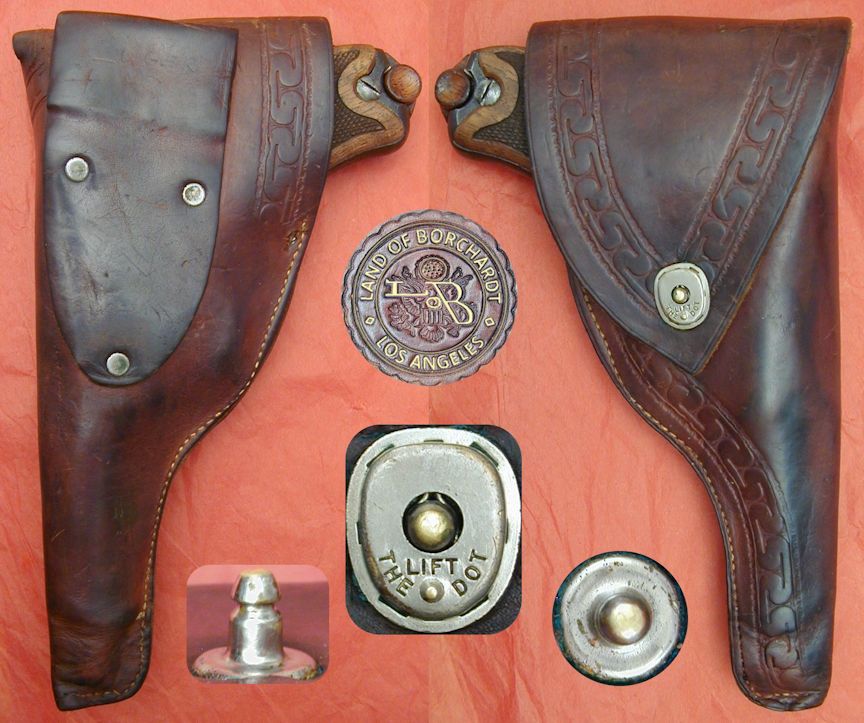
Pictured is example 3 of an unmarked, except for an aftermarket LUGER lightly scratched on the rear belt loop of the full cover flap, with closed toe holster. The holster which has a probable, period, well-known early manufacture replacement fastener closure mechanism titled and stamped THE LIFT DOT . The stylized border pattern, applied manually with an edge roller, is wider than examples 1 and 2, being ¾-inch. The cover flap lower edge terminates in a pointed, tear drop style. The rather wide rear belt loop, is attached with three rivets in a triangular pattern. The holster was made to hold an old or new model grip safety Luger with a 4¾-inch barrel. Although, a 4-inch 9mm barrel Luger was holstered for several years based on the partially collapsed holster body toe. The holster is pictured with 1899 Borchardt Luger 40. View 1 . View 2 .
Return to index
- Early commercial Luger holster for 3-5/8 inch or 98mm barrel

Pictured is an example of another holster of early Pre-WW1 manufacture with an equally early holster style with early style snap fastener closure, full cover flap, and closed toe assembly. The holster body border, front and rear and the cover flap border also has a very prominent, stylized but different floriated pattern. The holster rear has an angled belt loop, slightly wider than the Shapleigh Hardware offered Diamond holster , secured at the bottom by three pan-headed steel rivets and folded over at the top, secured by two pan-headed steel rivets. The holster body was originally made with a closed toe which is now open. Looking in the open toe opening, just before the exit, one can clearly see the impression of a sight blade. The toe opening diameter is too small for a Luger fat barrel, with the next option being a 1906 new model grip safety 9mm Luger. With the cover flap opened the impression of the left and right rear frame walls can be seen on the inside surface of the cover flap, and in the holster body can be seen the impression of the new model square face toggle knobs.
Inserting a new model grip safety 9mm, 4-inch barrel Luger, which seats perfectly with the cover flap closed and snapped, however, the rear of the frame does not come in contact with the existing rear frame impressions in the holster flap , also the 9mm barrel seats just short of the holster body exit, therefore this holster, although made for, did not always house a 100 mm barrel, new model Luger. Inserting a new model 4¾-inch 30 Cal grip safety commercial Luger, with the muzzle face flush to the modified open toe exit, is what left the distinctive sight blade impression in the leather , also the 9mm barrel seats just short of the holster body exit, therefore this holster, although made for, did not always house a 100 mm barrel, new model Luger. Inserting a new model 4¾-inch 30 Cal grip safety commercial Luger, with the muzzle face flush to the modified open toe exit, is what left the distinctive sight blade impression in the leather . The conclusions being, that the holster was originally made with a closed toe, to house a 9mm 4-inch barrel Luger, but was later modified by opening the holster toe to accommodate a 4¾-inch barrel Luger. . The conclusions being, that the holster was originally made with a closed toe, to house a 9mm 4-inch barrel Luger, but was later modified by opening the holster toe to accommodate a 4¾-inch barrel Luger.
Return to index
- Aftermarket Luger holster for 3-5/8 inch or 98mm barrel
- Early commercial steel stud holster for 4-inch or 100mm barrel
- Early commercial Luger holster 30L for 4¾-inch (120mm) barrel
- Early commercial Luger holster for 9mm 4-inch (100mm) barrel
- 1920s commercial holster for P.08 style Luger
1920s unidentified maker, well-constructed fancy style commercial holster with birdcage style snap fastener and leather strap closure for P.08 style Luger
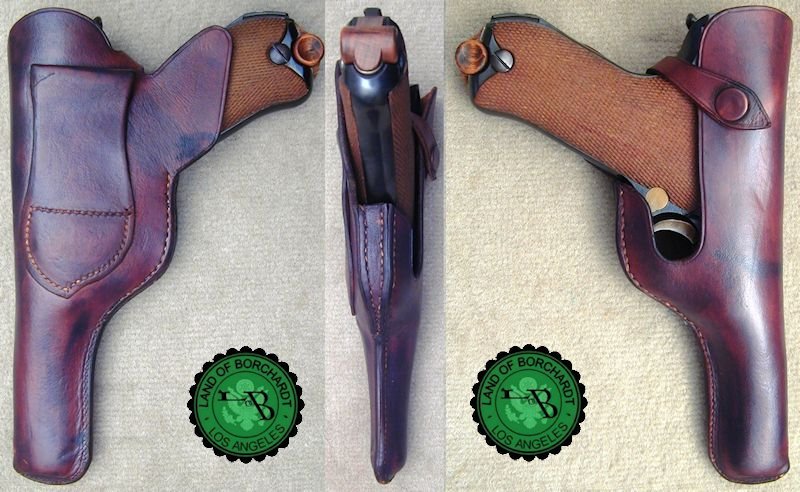
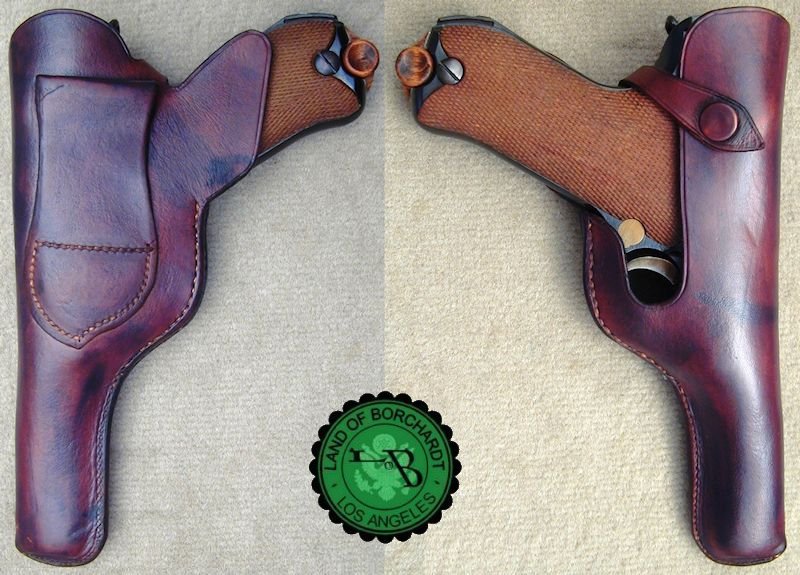

Return to index
- 1920s fancy hand carved open top and toe with snap fastener safety strap for 9mm 4-inch (100mm) barrel
- Classic Americana Luger holster with a hand-carved American Eagle

Classic Americana commercial Luger holster with a hand-carved, soaring American Eagle on the full cover flap along with a stylized upper case E, possibly the makers initial. Based on the coarse stitching pattern the holster appears to be a circa 1950s or later, one-off, hand made full cover flap with snap fastener closure and holster body closed toe, with the holster specifically made for a 1920s, probably Safe and Loaded marked, 30 Cal Luger with a 98mm or 3.86-inch barrel as a 102mm or 4-inch barrel Luger will not fit. on the full cover flap along with a stylized upper case E, possibly the makers initial. Based on the coarse stitching pattern the holster appears to be a circa 1950s or later, one-off, hand made full cover flap with snap fastener closure and holster body closed toe, with the holster specifically made for a 1920s, probably Safe and Loaded marked, 30 Cal Luger with a 98mm or 3.86-inch barrel as a 102mm or 4-inch barrel Luger will not fit.


Return to index
- Early full cover flap commercial Luger holster for 6-inch (150mm) barrel
- Early open top, closed toe, snap fastener safety strap closure shoulder holster for 4-inch barrel
- Early Western style, Mexican hand-carved, LUGER stamped commercial holster for 6-inch or 150mm barrel Navy
a) Example 1
b) Example 2
- Full cover flap, brass stud & slit closure holster for 4¾-inch barrel
- JF marked commercial holster for 6-inch or 150mm barrel Navy
- Unidentified commercial holster modified to fit 6-inch or 150mm barrel Navy
- Open top holster with carrying strap for 6-inch or 150mm barrel navy
- Early Wm. R. Burkhard offered commercial Luger holster for 98mm barrel

The pictured holster is a full cover flap open toe variation, will hold a 1902 American Eagle FAT barrel or a standard new model grip safety 9mm Luger . The inside surface of the cover flap at the holster body entrance has a partial impression of the left side silhouette of a Luger rear frame. This full flap holster is made of heavy russet leather with a beautiful floriated border design. The cover flap is secured to the holster body by a brass stud and slit. The holster comes close to identifying a leather maker as it has a style No. AF24 ½ stamped on the back-side belt loop , indicating at a minimum, a holster leather maker with more than one model in his line-up. The first thought is that AF4 is an abbreviation or the initials for Abercrombie & Fitch, but none of the A&F catalogs from 1903 through the 1930s used an AF4 designation in their catalogs, nor did Heiser in their holster catalogs. The AF4 could still mean A&F, however, attributed to an unknown leather maker. The closest identified holster advertisement for the subject AF24 ½ belt loop stamped holster associated with a No. 1304 listing is found in a 1920s catalog publication out of Saint Paul, Minnesota titled “Bargain List of Guns” Catalog No. 131, Wm R Burkhard . Interestingly, a full cover flap, brass stud and slit closure with the actual No. 1304 stamped on the belt loop has been identified and is featured herein with the identical No. 1304 listing found in a Pacific Hardrware and Steel catalog, except described for a 4½-inch (actually 4¾) barrel Luger.
Return to index
- Very early pre-WW1 commercial holster for an Old Model, 30 Cal Luger with a 4¾-inch barrel
- Mexican Durango ‘Scorpion’ hand-carved holster for 4-inch barrel Luger

Pictured is a rare Mexican full cover flap holster made for the German Luger Model 1908, or Model 1906 'American Eagle' in 9mm with 4-inch barrel . It is well known that early German automatic pistols were popular in Mexico and the American Southwest, among those who could afford them, in the 1900 - 1920 period.
This very high quality made holster, constructed of heavy russet leather with “wool” type lining has the neat feature of being hand engraved with a large Scorpion, which is a primary symbol of the "Border Country." The holster has a single, narrow loop on the back has the neat feature of being hand engraved with a large Scorpion, which is a primary symbol of the "Border Country." The holster has a single, narrow loop on the back and a short strap for carrying over the shoulder, or possibly mounting on a saddle, or steering column of an early automobile. and a short strap for carrying over the shoulder, or possibly mounting on a saddle, or steering column of an early automobile.
| | | |
| |
This ornately hand carved holster is in excellent condition with supple leather, excellent original surface, and tight stitching. There is a bit of wear on the inside flap lining.
A great Southwest/Mexican (1910-1920) Revolution era holster to display with a high condition Luger of the period. The holster dimensions are: 9-inches long by 5¼-inches wide at the top.
| |
| | | |
The above description, modified for clarity, is how the subject holster was advertised for sale. That the holster, made of medium thickness, quality russet leather was for a 4-inch barrel Luger is certain. The “Made in Mexico” statement, in conjunction with the uniquely Mexican hand carving, is probably true, as no known American leather maker uses such an unusual thread and coarse stitching pattern. The felt-like liner is also very unusual. The very well done, ornately hand carved holster, including the borders of the holster body, front and rear, and the unusually shaped cover flap, probably deliberately shaped to expose the upper portion of the holster body ornate hand carving, which is certainly not American, picturing a scorpion and a plant leaf on the holster body that looks suspiciously like a Marijuana plant , although, probably representing a local plant.
The entire 37-inch leather strap (½-inch wide and 0.11-inches thick) is also ornately hand carved, with a small belt-strap metal buckle, attached at one end by stitching. The strap is fed through a narrow belt loop-type leather attachment on the holster rear The strap is fed through a narrow belt loop-type leather attachment on the holster rear . Being thirty-seven inches long, the strap could have been strapped to the waist as people were smaller then, although this method of carrying the subject holster is not likely as the five adjustable belt/strap notch holes are only 0.3-inches apart, which means that the total adjustable length is barely an inch. This would be more typical of a strap than a belt. Other than the very ornate hand carvings, there are no maker marks on the holster or metal-snap fastener assembly. . Being thirty-seven inches long, the strap could have been strapped to the waist as people were smaller then, although this method of carrying the subject holster is not likely as the five adjustable belt/strap notch holes are only 0.3-inches apart, which means that the total adjustable length is barely an inch. This would be more typical of a strap than a belt. Other than the very ornate hand carvings, there are no maker marks on the holster or metal-snap fastener assembly.
Regarding the manufacture period of the holster, a P08 style, no chamber crest, pre-WW1 1914 model commercial 4-inch barrel, 9mm Luger fits well, as does a 1920s commercial 30 Cal Luger. The fact that Mexican companies offered pre-WW1 Lugers to their citizens (the general public) is established, as two pictured, circa 1910 Mexican catalogs advertise both, the old and new model commercial Luger. The first catalog being ARMERIA UNIVERSAL – Quintana Hnos. Sucs., - MEXICO D.F. , and the second catalog being TAMPICO NEWS CO., S.A. - MEXICO D.F. , and the second catalog being TAMPICO NEWS CO., S.A. - MEXICO D.F.
The seller’s comment that the scorpion is a primary symbol of the “Border Country” is partially correct. Although the scorpion is indeed a Mexican symbol, it is the symbol of the Mexican state of Durango, which is situated in the north central section of Mexico . With one of several cited methods of securing the holster by the seller, i.e. mounted to a saddle, is the most likely method, suggests that the holster was used by a Mexican cowboy in the state of Durango. The fact that Poncho Villa was born in Durango and the holster was used/made in the 1916 era – the time-frame of the Mexican revolution of independence – makes the seller’s comment not so farfetched. The holster was probably made by a Mexican saddle maker or leather worker, apparently being one of the countless ones made by American and Mexican independent saddle makers and leather workers of the time, on both sides of the border; they were legion in the West. . With one of several cited methods of securing the holster by the seller, i.e. mounted to a saddle, is the most likely method, suggests that the holster was used by a Mexican cowboy in the state of Durango. The fact that Poncho Villa was born in Durango and the holster was used/made in the 1916 era – the time-frame of the Mexican revolution of independence – makes the seller’s comment not so farfetched. The holster was probably made by a Mexican saddle maker or leather worker, apparently being one of the countless ones made by American and Mexican independent saddle makers and leather workers of the time, on both sides of the border; they were legion in the West.

Return to index
- Alligator or Cayman hide Luger holster for 3-5/8-inch or 98mm barrel

Pictured is a Luger holster made from the hide of an Alligator or Caiman, it features the real head of a baby Alligator or Caiman which measures 3" x 1¼" at the top as it tapers down to ½". The head has beautiful inset eyeballs and you can even feel and see the little baby teeth on both sides of the mouth. It is beautifully made and a P.08 style Luger pistol fits in it perfectly . The belt, shown below, is equally interesting, being 27-inches long x 2-inches wide with a silver color metal belt buckle at each end and with the outside pattern of the belt similar to the holster front with the backside belt surface identical to the backside of the holster. There is an additional separate belt section 13 inches x 1-inch with a larger oval shaped, 3-inch high center section made of the heavy top scales of the Alligator. On each side or the center are 5 brown baked enamel eyelets for the buckle. Per the previous owner there is a missing belt section, however the combined belt length of 40 inches seems adequate or complete.
 The workmanship of both the matching belt and the holster is very impressive, no doubt done by a professional leather maker.
The workmanship of both the matching belt and the holster is very impressive, no doubt done by a professional leather maker. The holster and belt consists of two pieces layered, with the top external Alligator surface and the backside being the smoother under belly, stitched together with two rows of tightly stitched, fine thread. The dating of the holster is difficult to identify with no maker’s marks, but based on the old birdcage style of snap fastener, places the manufacture to the 1920s or 1930s. The holster could be of central or South American origins as there are other Alligator identified holsters, one in particular, a non-Luger holster made in Honduras made in Honduras , the holster rig and twin magazine pouch .

Return to index
- Luger holster, ink stamped style LUGER 35/8 N0. 6002 for 3-5/8" or 98mm barrel
- Luger open top, open toe safety strap snap fastener for 3-5/8" or 98mm barrel
- Hand-carved holster for “Cal 9mm No. 11 Brown” 4-inch barrel
- Erma Luger belt loop stamped, full cover flap holster for Erma Luger LA-22
- Mexican hand-carved Luger holster marked in ink B-4 for 3-5/8-inch or 98mm barrel
- Basket weave, full cover flap holster for 3-5/8-inch or 98mm barrel
Pictured are two unmarked examples of very stylized, hand tooled Basket weave pattern, full cover flap snap fastener Luger holsters, both for a 4-inch barrel Luger. The holsters are virtually identical in size and style with unusual shaped cover flaps. The Basket weave pattern of the first example covers the front cover flap and holster body and the upper portion of the rear, whereas, the second example Basket weave pattern completely covers the front and rear of the holster. Pictured are the front and rear view of both examples.

Return to index
a) Basket weave style V1 holster
b) Basket weave style V2 holster
- Left hand basket weave style V1 full cover flap snap fastener closure Luger holster for 4-inch or 100mm barrel
- Basket weave style holster for 4-inch or 100mm barrel
- Oak Leaf pattern style full cover flap holsters
a) Holster for 4¾-inch or 120mm barrel
b) Holster for 4-inch or 100mm barrel
- Floriated style pattern with holster length full cover flap with Buffalo Nickel logo snap fastener for 4-inch or 100mm barrel
- Mexican hand carved holster not for a Luger yet snugly fits a P.08 style Luger
Very fancy Mexican hand carved open top closed toe holster not made for a Luger yet snugly fits a P.08 style Luger

Return to index
- Full cover flap holster with metal twist-turn closure for a 4-inch barrel
Full cover flap with a large oak leaf floriated design on the cover flap with metal twist-turn catch type closure for a 4-inch barrel


Return to index
- Left handed concealment holster for a 4-inch barrel Luger P 08 style marked HEARD
Left handed concealment holster for a 4-inch barrel Luger P 08 style marked HEARD and features a thumb break retention strap

Return to index
- Mexican hand-carved holster for 98mm barrel Luger

Pictured is an exceptional, high quality, hand carved, well-constructed open top belt loop holster for a 1920s – 1930s 4-inch barrel commercial Luger with unusual spine attached magazine pouch, first example seen on this early style holster. As stated, the holster is for a 4-inch barrel Luger and is unusual, mostly for its lack of any markings whatsoever. The holster is exceptionally rugged, sturdy, and well-constructed, having a nominal wall thickness of 3.8 mm and with the holster front, and attached magazine pouch, exquisitely hand-carved. The holster body toe is closed, except for a deliberate weep hole, using a 5.35 mm thick, wafered leather piece that extends around the entire holster body stitched edge making a 13-mm thick, three-layer edge section, resulting in a very strong holster. using a 5.35 mm thick, wafered leather piece that extends around the entire holster body stitched edge making a 13-mm thick, three-layer edge section, resulting in a very strong holster.
This is the first open top holster of this early style category observed with an added magazine pouch on the spine. That the holster is custom made is certain, and because it is so well done, it most likely would have been made by a noted leather maker. The holster shows long term storage of a Luger and especially of a spare magazine as evidenced by the deep impression left of the circular edge wooden toggle knob That the holster is custom made is certain, and because it is so well done, it most likely would have been made by a noted leather maker. The holster shows long term storage of a Luger and especially of a spare magazine as evidenced by the deep impression left of the circular edge wooden toggle knob . The closest comparison of this holster is to an S.D. Myres creation, similar to one pictured in Luger Holsters and Accessories of the 20th Century by E. Bender on page 605.[1] This fancy hand carving is not unusual, and has been seen on H.H. Heiser, Colorado Saddlery holsters and several other leather makers. . The closest comparison of this holster is to an S.D. Myres creation, similar to one pictured in Luger Holsters and Accessories of the 20th Century by E. Bender on page 605.[1] This fancy hand carving is not unusual, and has been seen on H.H. Heiser, Colorado Saddlery holsters and several other leather makers.
A unique feature to this otherwise perfect holster, upon a detailed examination can be seen on the front of the holster, just below the trigger cutout, is what appears to be a section where part of the raised design has been removed, which looks at one time to have been some ones’ initials . The area appears to be reworked to make the modified area similar or blend into its surroundings. There are a couple of possibilities that could account for the modification; . The area appears to be reworked to make the modified area similar or blend into its surroundings. There are a couple of possibilities that could account for the modification;
- the holster was made to an individual’s order, including his initials and for whatever reason the buyer did not complete the transaction and the leather maker removed the initials,
- the holster could have been purchased by a second individual who had the previous owner’s initials removed.
What is certain is that what was removed was not the leather makers’ identification.
[1] Luger Holsters and Accessories of the 20th Century, p.605 by E. Bender, ©1992.
Return to index
- Mexican hand-carved holster with soft bleached elk skin
"Unknown maker", very fancy Mexican hand-carved, open top toe plug safety strap with Latigo laced borders fold-over holster with soft bleached elk skin lining and backing

Pictured are two separate views of a very fancy, Western style fully floral hand tool carved, open top closed toe safety strap 4-inch barrel Luger holster, lined in elk skin with black Latigo laced leather edges with a fully floral Latigo laced snap fastener closure style safety strap. The holster is unmarked and the maker is unknown. The work and condition is exceptional and could be S.D. Myres of El Paso, Texas. The excellent condition for a little used holster, possibly made in the 1940s or 1950s, was most likely custom order made for special occasions, such as a parade or social event.

Return to index
- PDZ unknown maker commercial holster for 4-inch barrel Luger
- Unusual MH marked P38 holster to P08 commercial hybrid
The hand-written description on the hang tag attached to this holster indicates it originally holstered a P-38 serial number 9160B, a GI war trophy “bring-back” by P.F.C. W.L. Empkey 37724582 . The holster has subsequently changed owners as the holster cover flap sports the initials MH which is probably when the holster was modified to house a P.08 style Luger by adding an extended toe section. It is the extension that is very unusual being brown leather with a toe plug, apparently sacrificing the top end of a holster. Accordingly, the holster is considered to be an American conversion. . The holster has subsequently changed owners as the holster cover flap sports the initials MH which is probably when the holster was modified to house a P.08 style Luger by adding an extended toe section. It is the extension that is very unusual being brown leather with a toe plug, apparently sacrificing the top end of a holster. Accordingly, the holster is considered to be an American conversion.


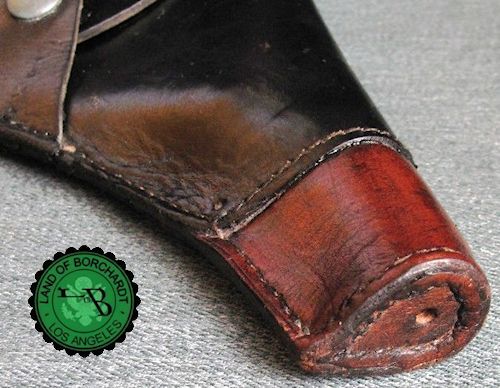
Return to index
- The Lift Dot P08 style commercial holster with aftermarket added WaA135 WaffenAmt stamp
- Unique commercial holster for 4¾ -inch barrel Luger
- Unidentified commercial P08 shoulder holster
- Luger shoulder holster with two attached magazine pouches
- Akron Ohio unknown maker commercial holster
- Heavy duty, full cover flap, snap fastener commercial holster for P08 style Luger
- Hard shell, strap and buckle flap closure holster with for 4-inch barrel Luger
- Open top holster with early style ‘bird cage’ style snap fastener closure for 4-inch barrel Luger
- Full cover flap, snap fastener closure for 4¾-inch barrel Luger
- Full cover flap holster with unusual snap fastener, leather strap closure
- Full cover flap with holster body magazine pouch for 4¾-barrel Luger
- Pebble grain style commercial P08 holster, variation 1
- Pebble grain, full cover flap holster for P.08 style Luger, variation 2
- Rare 1920s holster board-stock for 180mm commercial Artillery Luger
Pictured are multiple views of a rare, unidentified maker 1920s commercial Artillery Luger holster board – stock affixed to a 1920s Pacific Arms Corporation or PAC commercial Artillery Luger using an excessed or spare Crown S property marked Artillery board-stock . Pictured is the PAC Artillery Luger partially inserted into the holster . Pictured is the PAC Artillery Luger partially inserted into the holster . The full cover flap is secured to the holster body with metal buckle and leather strap. The holster body toe is affixed to the board-stock neck in the traditional military manner. The holster body has an unusual sturdy thick leather, large size attached, tapered twin magazine pouch with the magazines inserted perpendicular or front to rear. . The full cover flap is secured to the holster body with metal buckle and leather strap. The holster body toe is affixed to the board-stock neck in the traditional military manner. The holster body has an unusual sturdy thick leather, large size attached, tapered twin magazine pouch with the magazines inserted perpendicular or front to rear. The magazine cover flap is secured to magazine body with an unusually large, two centimeter diameter, old birdcage style 1920s or earlier period snap fastener assembly The magazine cover flap is secured to magazine body with an unusually large, two centimeter diameter, old birdcage style 1920s or earlier period snap fastener assembly . The holster is attached to the artillery board-stock with a large leather strip attached to the board-stock back side folded over to form a belt loop, secured with two screws and brass washers. The leather parallel side “belt loop” strip is fed through a second leather strip attached perpendicular or lateral to the artillery stock, which acts as the upper restraint for the belt loop, also secured with two screws and brass washers . The holster is attached to the artillery board-stock with a large leather strip attached to the board-stock back side folded over to form a belt loop, secured with two screws and brass washers. The leather parallel side “belt loop” strip is fed through a second leather strip attached perpendicular or lateral to the artillery stock, which acts as the upper restraint for the belt loop, also secured with two screws and brass washers , which feeds over the top of the wooden stock and tapers down to form a strap that is secured to a steel buckle attached to the cover flap. This ornate configuration is unique to this assembly. There is, however, a similar holster style artillery board style rig being offered on a web site by a noted Luger dealer. , which feeds over the top of the wooden stock and tapers down to form a strap that is secured to a steel buckle attached to the cover flap. This ornate configuration is unique to this assembly. There is, however, a similar holster style artillery board style rig being offered on a web site by a noted Luger dealer.

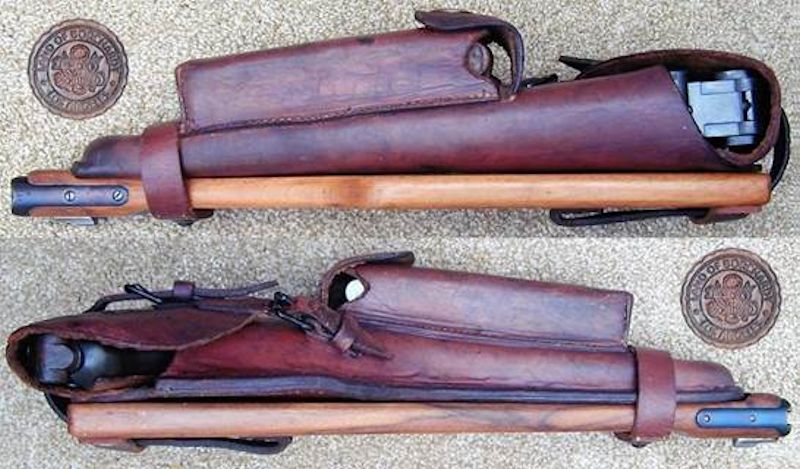
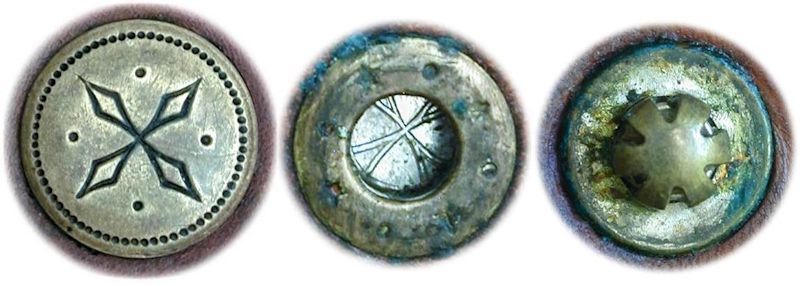
Return to index
- Rare 1920s dual leather scabbard for 12-inch barrel Luger and navy board stock with single magazine leather pouch

Very rare 1920s dual leather scabbard for 12-inch barrel Luger and navy board stock and leather sling with single leather magazine pouch . A double holster pattern with the stock carried in a detachable subsidiary pouch at the rear of the pistol holster, the essemble being carried by shoulder strap or belt loop.

Return to index
- 1970’s – 1980’s American made aftermarket pre-WW1 or 1920’s style German commercial holster
American Commercial Artillery Luger Holsters: Unknown maker
- Earliest known circa 1920’s commercial Luger holster for 8-inch (200mm) barrel Artillery Luger marked 120 over 11

The early 1920s designation of the subject commercial Artillery Luger holster is based on comparisons of similar period style commercial Luger holsters. These early style holsters were not necessarily sold directly by the holster maker, but were merchandised by salesmen, sometimes by the holster maker, to local gun dealers and general hardware stores for across-the-counter sales and, in some cases, offered through their catalogs for sale to customers. That the 120/11 number is the holster maker’s designation is certain, but when sold through a catalog the holster was assigned an additional inventory number. Pictured below is one such catalog advertising example of a similar period style commercial Luger holster.

Return to Artillery index
- Circa 1920s black dyed, tapered cover flap with brass stud and slit closure, open toe holster body for 8-inch or 200mm barrel Artillery
- 1920s Fancy Commercial Artillery holster
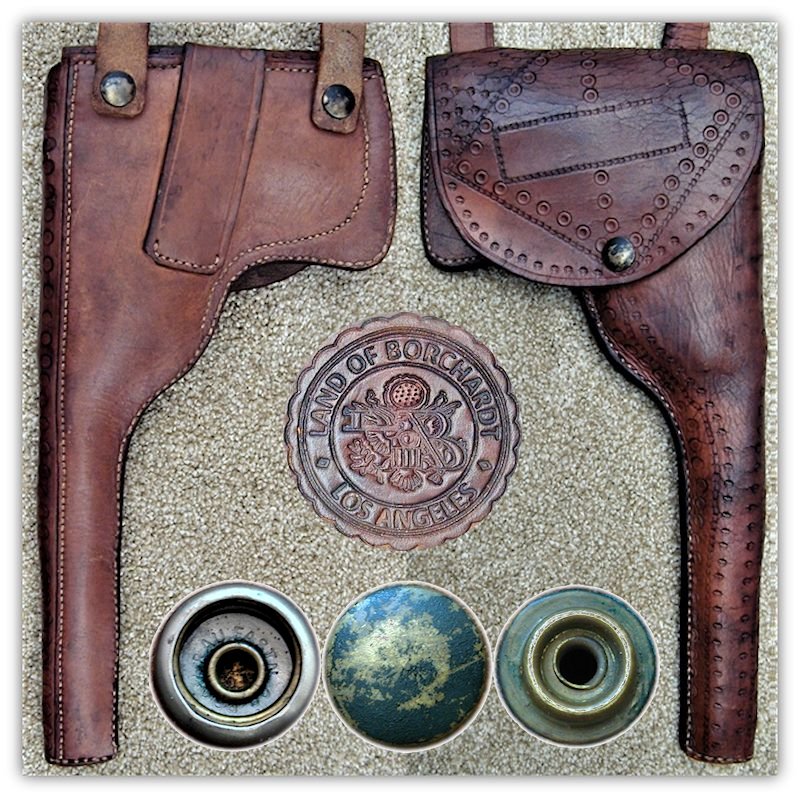
Pictured is a 1920s fancy commercial, full cover flap Artillery Luger holster with holster body toe plug and a very sturdy 19mm wide x 3mm thick x approximately 9½-inches long holster body pull-up strap. Attached to the holster rear is a combination single belt loop/removeable, 36-inch adjustable shoulder strap carry with two snap fasteners and a very sturdy 19mm wide x 3mm thick x approximately 9½-inches long holster body pull-up strap. Attached to the holster rear is a combination single belt loop/removeable, 36-inch adjustable shoulder strap carry with two snap fasteners , and a black enamel, steel buckle and leather keeper , and a black enamel, steel buckle and leather keeper . .
The holster was well, constructed in the early 1920s by an unknown American leather maker who used three “RAU”, Providence, Rhode Island snap fasteners [2]; one on the cover flap and two to secure the adjustable shoulder strap to the holster body rear [2]; one on the cover flap and two to secure the adjustable shoulder strap to the holster body rear . .
The holster body interior is not lined, but the rear side is layered, utilizing a separate leather backing or panel, where the two female snap fasteners were installed first, before attaching the panel, by stitching to the holster, concealing the back side of the metal fasteners, necessary for avoiding metal-to-metal contact while inserting or withdrawing a pistol.
1) Two views of holster with commercial A.F. Stoeger, Inc. Artillery Luger with 3-line Stoeger address.
2) Holster with partially inserted pistol.
3) Close-up view with partially inserted pistol.
4) Holster with fully inserted pistol.
[2] In 1911, Reiter started a small company, located on Blount Street in Providence, Rhode Island, staffed by four employees, producing metal stampings and fasteners for fabric. Rau Fasteners Mill Complex in Providence, RI – EPA Website. 1890's: Rau Fasteners factory begins operations.
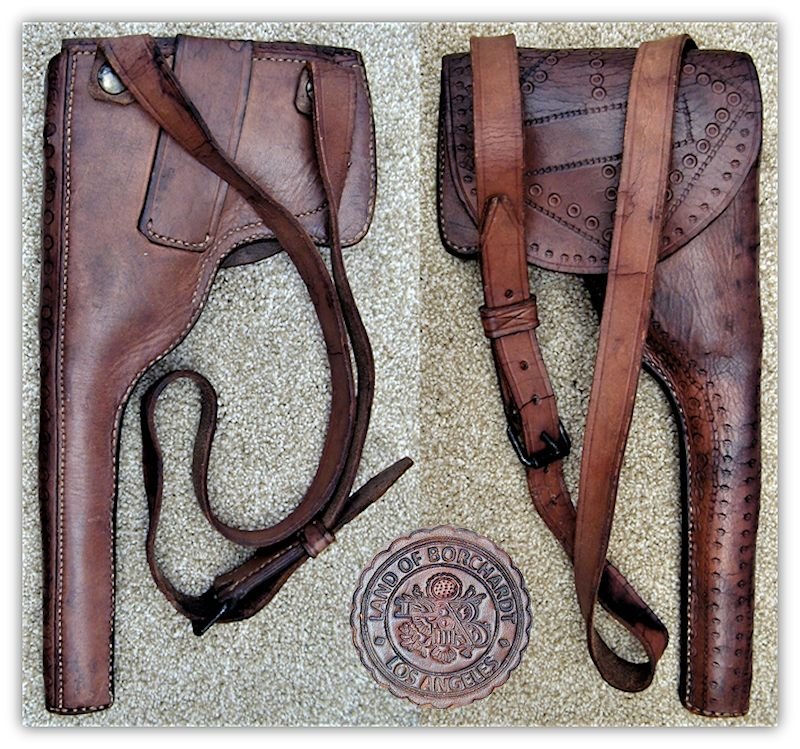
Return to Artillery index
- Circa 1920s Luger holster basket weave style for 8-inch or 200mm barrel Artillery
- Circa 1920s full cover flap Luger holster for 8-inch or 200mm barrel Artillery
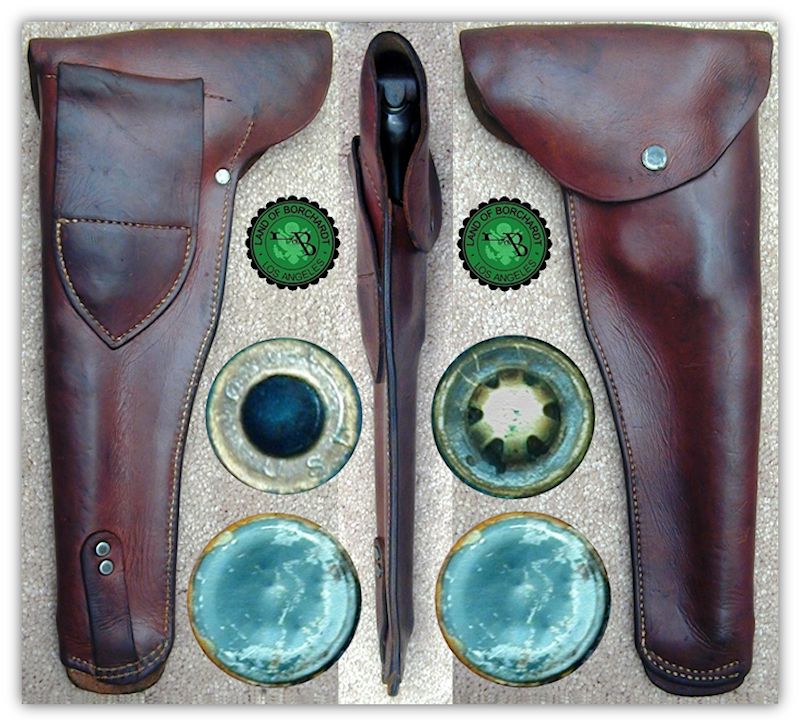
1920s unknown American holster maker, full cover flap, closed toe, large single belt loop Artillery Luger holster with early style bird cage type snap fastener assembly made by the U. S. Fastener Company. The holster body toe has an added leather loop for attachment to the leg.
Return to Artillery index
- Full cover flap snap fastener, Mexican hand carved Luger holster for 8-inch or 200mm barrel Artillery
- Aftermarket holster modified for 8-inch or 200mm barrel Artillery Luger
- E.GAY stamped open top, toe plug holster, possibly made for 8-inch or 200mm barrel Artillery
- Aftermarket Luger holster with magazine pouch made for 8-inch or 200mm barrel Artillery
- Shoulder holster made for 8-inch or 200mm barrel Artillery Luger, marked 100 – L U G E R – 8
- Radom holster with magazine pouch modified to fit 8-inch or 200mm barrel Artillery
- Open top, closed toe, aftermarket holster for 8-inch or 200mm barrel Artillery
- M1911 style, left-side, full cover flap with brass stud and slit closure holster for an 8-inch or 200mm barrel Artillery
- Sturdy box-style body, closed toe, thin leather cover flap with no closure mechanism for 8-inch or 200mm barrel Artillery
- Circa 1920s unknown maker, brass stud and slit up-strap closure, full cover flap with toe plug commercial holster for 8-inch or 200mm barrel Artillery
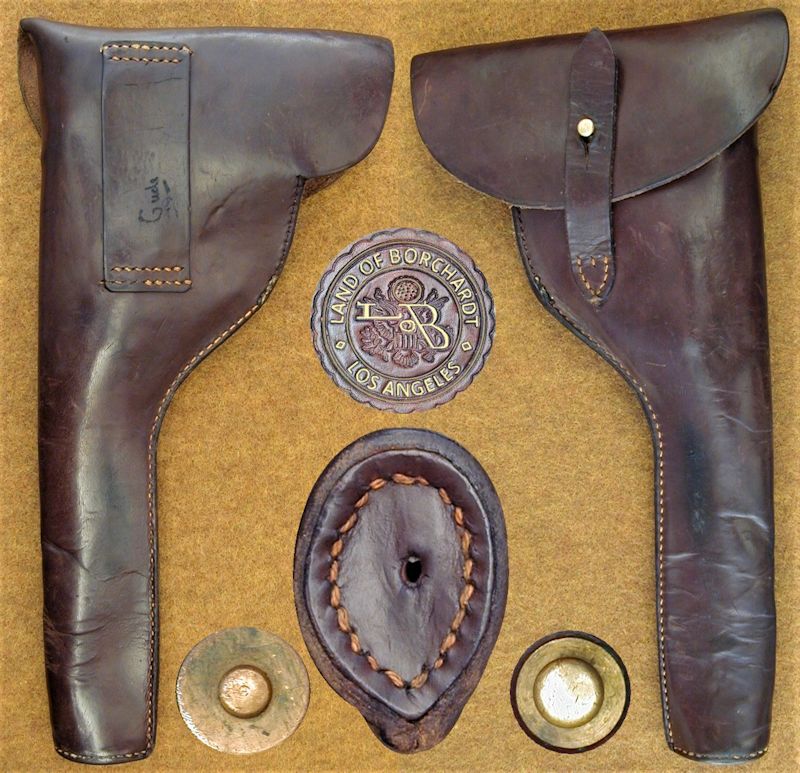
It is well-known that the early German made Model 1900 commercial Luger, tear-drop style full cover flap holsters for the 120 mm 30 Cal barrel Lugers utilized brass stud and slit closures with the belt buckle/roller and down-strap closure introduced circa 1906. It is also well-known that the military excessed LP.08 Artillery and commercial Artillery Lugers weren’t available in the United States until the 1920s.
The conclusion being that the subject commercial Artillery holster with its brass stud and slit, up-strap holster closure was made in the 1920s. Since most of the known American holster makers, pre-WW1 and 1920s, such as Heiser and Lawrence utilized snap fastener closures, its quite possible, despite the American type toe plug that the subject commercial Artillery holster could have been made in Germany as German made Artillery holster examples exists, albeit rare, with toe plugs that the subject commercial Artillery holster could have been made in Germany as German made Artillery holster examples exists, albeit rare, with toe plugs . .
Pictured are two other views of the subject holster. View 1 and View 2 and View 2 . .
Return to Artillery index
- Aftermarket commercial, full cover flap LP08 Artillery holster
Possibly American made aftermarket commercial, full cover flap LP08 Artillery holster modeled after the German army military variation of the Artillery holster with shoulder straps and brass fittings. The holster is at least 70 years old based on the old style snap fasteners used on the loading tool pouch and the cleaning rod cover flap vs. the original slit and brass stud closure method used with the original Imperial German Army Artillery LP08 holsters.
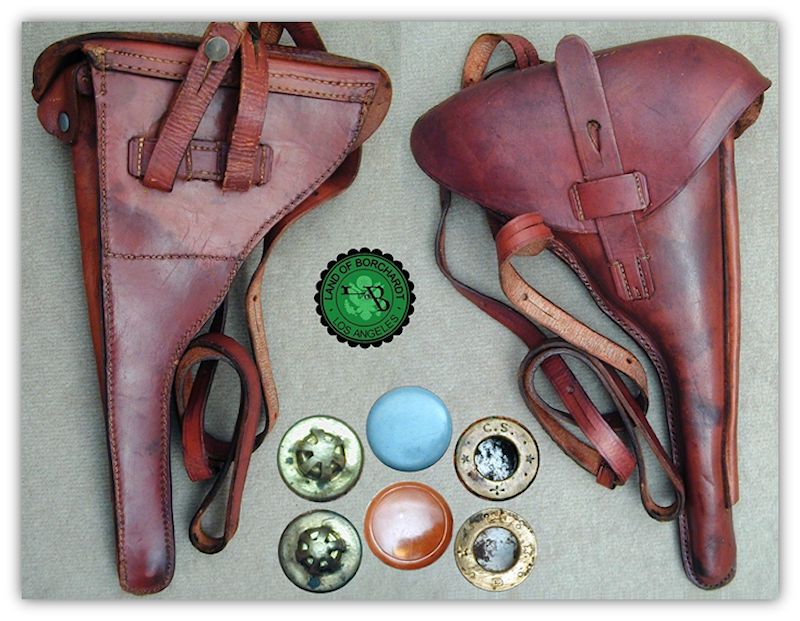
The earliest snap fasteners were of the bird-cage type -- a dome slit by longitudinal perforations and a rigid ring as a socket into which the dome was forced.
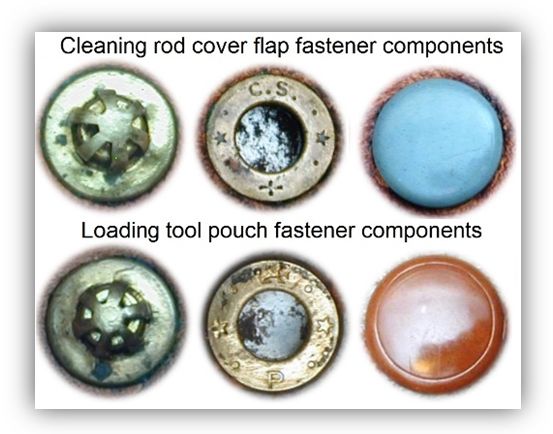
Return to Artillery index
- 1920s commercial Artillery Luger board-stock holster
Pictured below is a 1920s – 1930s uniquely configured, unknown maker Artillery Luger WW1 surplus flat board-stock with attached full cover flap leather holster and integral twin magazine pouch, one of three commercial Artillery holster-stock examples discussed in this article.
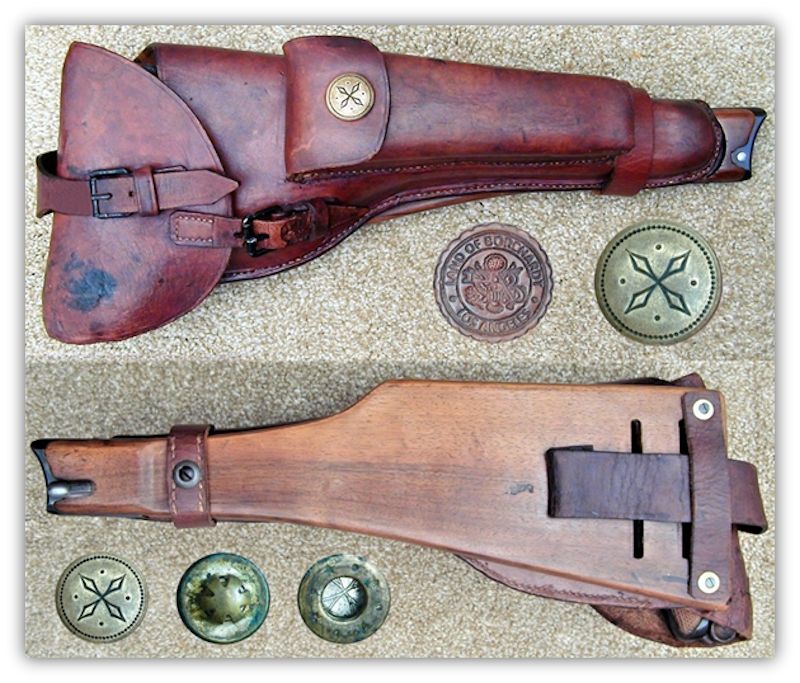
The subject unknown maker commercial artillery holster is attached to the 8739b stamped attaching iron artillery flat board-stock, similar to its WW1 German army counterpart . The bottom of the holster is secured to the stock with a toe strap. The top of the holster body and cover flap, at the entrance, is firmly secured to the board-stock with three flush-mount, wood screws and brass washers to the stock . The bottom of the holster is secured to the stock with a toe strap. The top of the holster body and cover flap, at the entrance, is firmly secured to the board-stock with three flush-mount, wood screws and brass washers to the stock , along with a leather strap and buckle. , along with a leather strap and buckle.
The 1-3/8-inch wide belt loop leather strap feeds through a 6-inch x ¾-inch, perpendicular affixed leather strap then folds over the left side board-stock rear edge to the cover flap, tapering down to a ?-inch wide, perforated strap which is secured to the cover flap via a cover flap attached metal buckle and leather keeper. The perpendicular strip of leather is attached at the rear section of the board-stock over the fold-over leather strap to hold the strap in place and form the upper restraint portion of the belt loop. The cover flap is secured to the holster body with another leather strap with leather keeper and buckle.
An unusually large magazine leather pouch with a full cover flap is attached to the holster body. The magazine pouch, full cover flap is secured to the magazine pouch body using a rather large ¾-inch diameter stylized, period bird-cage snap fastener assembly. Pictured is the magazine pouch with the cover flap open showing two inserted wooden bottom magazines. The magazine pouch, full cover flap is secured to the magazine pouch body using a rather large ¾-inch diameter stylized, period bird-cage snap fastener assembly. Pictured is the magazine pouch with the cover flap open showing two inserted wooden bottom magazines.
The subject holster, obviously will work with any Artillery Luger, be it a German military model or 1920s commercial variation and was probably specially made for a customer. A classic match for the subject holster would be a Pacific Arms Corporation or PAC commercial Artillery Luger. Pictured is the holster with PAC Artillery Luger Pictured is the holster with PAC Artillery Luger and with the PAC Artillery Luger partially inserted in the subject holster and with the PAC Artillery Luger partially inserted in the subject holster . .
Von Lengerke & Detmold
This subject commercial Artillery holster board/stock configuration is not unheard-of as a similar configuration exists, being made for or by the New York city retail firm of Von Lengerke & Detmold a.k.a. VL&D as of Jan 2021 being advertised by a US mid-west gun dealer . .
And yet another VL&D commercial Artillery holster board/stock rig is pictured in Luger Holsters and Accessories © 1992 by E. Bender on page 632. This rig is very suspicious, based on the accompanying description stating that: In 1912-13 prior to acceptance by the German army, the Deutsche Waffen Und Munitionsfabriken (DWM) produced this “salesman’s Sample” for the New York firm of Von Lengerke & Detmold. This rig is very suspicious, based on the accompanying description stating that: In 1912-13 prior to acceptance by the German army, the Deutsche Waffen Und Munitionsfabriken (DWM) produced this “salesman’s Sample” for the New York firm of Von Lengerke & Detmold.
This statement is a total fabrication because in 1912 the Artillery Luger did not exist until 1913 and only then as a proprietary pre-production prototype of approximately twenty submitted to the German Army with a prototype wooden holster stock hollowed out to hold the prototype Artillery Luger with both wooden stock with Artillery Luger sheathed in a prototype leather holster . The Artillery flat board/stock was not introduced until 1914. This is all detailed in two articles on this site: . The Artillery flat board/stock was not introduced until 1914. This is all detailed in two articles on this site:
- The Last Pre-World War I DWM Prototype: The Artillery Luger,
- Artillery prototype stocks 32, 37, 39 and 52 comparisons.
The Bender pictured board-stock itself is correct being Germany export stamped, in the 1920s or 1930s, not in 1912 or 1913. The Crown/N stamping is a commercial Nitro proof and is not usually seen stamped on wood. Furthermore, while the VL&D logo stamped holster is also correct, it was made by or for VL&D, not DWM, as DWM did not make holsters and additionally would not make a holster with a squared-off holster toe.
As pictured in the Bender book the shoulder strap had to be partially removed in able to move the board stock out of the way to see the curiously, hidden VL&D logo. The wooden board/stock also has a fold-over attached leather strap for belt carry, possibly added later.
The Sturgess/Simpson Ltd VL&D Artillery board/stock is a completely different configuration, possibly, as stated in the TBLAP, Figure 19-28 description, made for VL&D by H.H. Heiser is a completely different configuration, possibly, as stated in the TBLAP, Figure 19-28 description, made for VL&D by H.H. Heiser . The holster is secured to the flat board/stock by three small attaching, adjustable buckle straps, one at the holster toe and the other two at the rear of the board/stock. It is not certain how it was carried, possibly by feeding a belt through the two upper adjustable buckle straps, which also serve to secure the flat board/stock to the rear of the holster. . The holster is secured to the flat board/stock by three small attaching, adjustable buckle straps, one at the holster toe and the other two at the rear of the board/stock. It is not certain how it was carried, possibly by feeding a belt through the two upper adjustable buckle straps, which also serve to secure the flat board/stock to the rear of the holster.
It is interesting that VL&D would have two different variations of an Artillery holster board/stock. One possibility is that VL&D had such a low demand or requests for this configuration that by the time there was another request for this variation, a different leathermaker was used. had such a low demand or requests for this configuration that by the time there was another request for this variation, a different leathermaker was used.
Additionally, per the 1930 Abercrombie & Fitch catalog introduction page catalog introduction page VL&D sold out or merged with Abercrombie & Fitch, a.k.a. A&F and that VL&D offered only the 1920s 30 Cal Luger pistols in their 1927-28 VL&D catalog on page 106 as G410 LUGER .30 CAL. and interestingly the entire page 106 VL&D gun offerings appeared in the 1930 A&F catalog on page 109, now as F410 LUGER .30 CAL. VL&D sold out or merged with Abercrombie & Fitch, a.k.a. A&F and that VL&D offered only the 1920s 30 Cal Luger pistols in their 1927-28 VL&D catalog on page 106 as G410 LUGER .30 CAL. and interestingly the entire page 106 VL&D gun offerings appeared in the 1930 A&F catalog on page 109, now as F410 LUGER .30 CAL. Based on this information it can be reasonably concluded that the two featured VL&D Artillery holster board/stock variations were VL&D offerings of the 1920s, along with the subject unknown maker Artillery holster board/stock Based on this information it can be reasonably concluded that the two featured VL&D Artillery holster board/stock variations were VL&D offerings of the 1920s, along with the subject unknown maker Artillery holster board/stock . Pictured for comparison are both VL&D Artillery board/stock variations . Pictured for comparison are both VL&D Artillery board/stock variations . .
Return to Artillery index
|
|
© 2018, Land of Borchardt, All rights reserved.
|